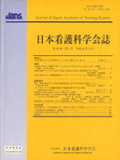Japanese
English
- 販売していません
- Abstract 文献概要
- 参考文献 Reference
要旨
目的:在宅高齢者終末期の時期別期間とこの間に実施された訪問看護の頻度と体制について,がんとがん以外の事例を比較しつつ明らかにする.
方法:「良い」看護を提供していると判断される訪問看護ステーションの看護師31名から65歳以上のがん・がん以外の事例1件ずつ聴取し,終末期期間を分け「開始期」「維持期」「悪化期」「臨死期」について分析した.各期の期間・訪問頻度等を集計しがんとがん以外の事例を統計的に比較検討した.
結果:がん以外の事例はがん事例に比べ開始期と悪化期が有意に長く,長さは多様だった.訪問頻度はがん事例では臨死期から高く,がん以外の事例は悪化期から高くなった.緊急訪問はがん以外の事例の臨死期に約半数で実施されていた.
結論:がんとがん以外の事例で異なる経過と訪問看護の提供状況が見られ,事例毎に適切な看護が提供できるような制度上の工夫が看護師の技術向上とともに求められる.
Abstract
Objective:We examined the duration of specific stages in the end-of-life period of older adults living at home, and the changes in the frequency and other structures of nurses' home visits during these stages. We compared cancer and non-cancer cases.
Method:Thirty-one nurses from home care nursing stations where “good” nursing care is provided, were interviewed concerning the practice of end-of-life care for patients that were 65 years and over, in both cancer and non-cancer cases. The end-of-life period was classified into onset, maintenance, worsening, and dying stages, and the differences in duration, visit frequency and other structural characteristics in each stage were statistically compared between cancer and non-cancer cases.
Results:The length of the onset and worsening stages among non-cancer cases was significantly longer and more varied than that among cancer cases. The visit frequency for cancer cases became significantly higher in the dying stage, while it became higher from the worsening stage among non-cancer cases. On-call home visits were provided for almost half of the non-cancer cases in the dying stage.
Conclusion:The findings suggest that the necessary end-of-life care, and the frequency of nurses' home visits were different between cancer and non-cancer cases. In order to provide appropriate care for each patient, improvement in the reimbursement system for home care nursing, as well as the skills of individual nurses, may need to be considered.
Copyright © 2011, Japan Academy of Nursing Science. All rights reserved.


